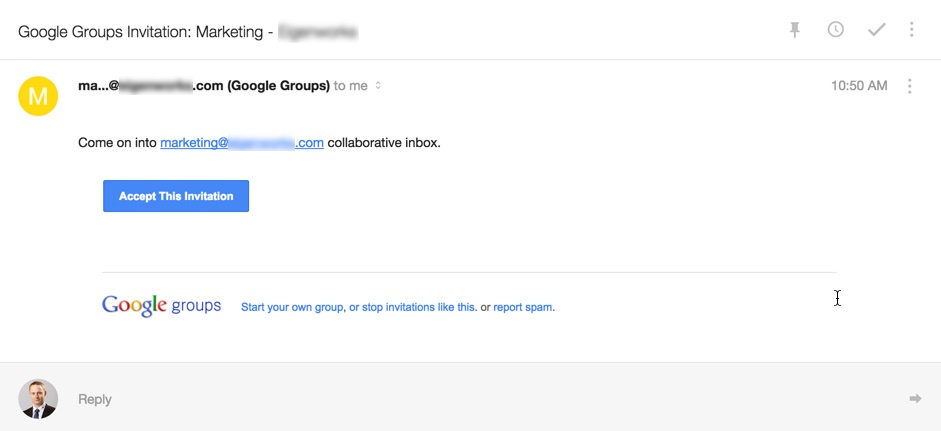

Google Groups now has a feature which allows you to create them as a Collaborative Inbox. If you have Google Apps for Business, you can setup a group that allows you to collaborate amongst a team with a shared email address. That means you could setup support@yourdomain.com, marketing@yourdomain.com or any other team@yourdomain.com that makes sense. It also allows the client to be the owner of the account with full visibility of what’s happened in the past even after we part ways.
We use it with clients to share an email address, so that we can act on their behalf. We help our clients setup the inbox on their domain so we access the emails, register for services and take the work that emails prompt. It is a team inbox, that allows you to assign messages to team members and news which haven’t been processed yet are shown as such.
Setting up your first one can take as little as 15 minutes, but it took us about an hour of work trying to get the settings correct. As in our case, we want to allow people who are external to your business to access the group. We eventually found the groups global setting in the Google Apps Administration, which we’ll explain below.
Step 1: Enable Groups for the Domain
Your Google Administrator also has to enable Groups for your domain. Go to https://support.google.com/a/answer/167096 and follow the instructions provided by Google.
Step 2: Allow External User Access
(Optional) This step depends on whether or not you want users from another domain (company) to access the collaborative inbox. In marketing partnerships, this is exactly what we want, to allow the agency to access the client inbox.
To set sharing options for Groups for Business:
- Sign in to the Google Admin console.
- From the dashboard, go to Apps > Google Apps > Groups for Business.
- Click Sharing settings or Advanced settings.
- Select your preferences in the Sharing Options section.
- Set the Outside this domain – access to groups to “Public on the Internet”.
Step 3: Create the Group
You can create the group from the Google Groups page. The initial view you see is your public groups view, to create your group for your business, switch to your organization view.
Then, select Create a Group. Pick your team name, e.g. marketing, and then pick the group type “Collaborative Inbox”.
Step 4: Adjust Group Settings
Check and adjust the other settings to your preferences and as necessary. There’s lots of options which I’m not covering here, and if you are interested go to the Google Groups Help Center. After you’ve created the group you have plenty of options to further configure the groups rules for members, messages, settings, permissions, roles, and information.
Step 5: Invite Users
After pressing ‘Create’ above, you’ll get a popup inviting you to invite users to collaborate. Click through, add the email addresses of your users and send them a short message inviting them to accept the invitation for the group.
Step 6: Users Accept invitation to Collaborate
Users are notified by email, invited to accept and then they’ll immediately be able to participate, read the messages to the collaborative inbox.



